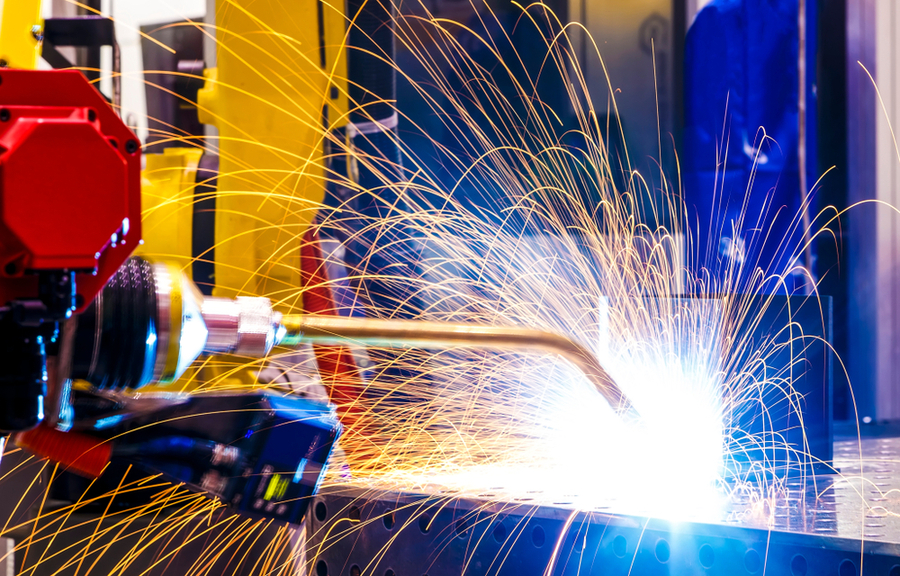Tractor Maker John Deere Using AI on Assembly Lines to Discover and Fix Hidden Defective Welds

It’s never been easy to detect defective welds in machinery. That’s because it is difficult to see deep inside welds to check for proper and complete bonding as metal parts are melded together with precision on factory assembly lines.
But in a partnership with Intel Corp., John Deere, the makers of complex, mechanized farm tractors, combines, construction equipment, forestry machinery and more, is using AI computer vision on a robotic assembly line to carefully inspect and immediately fix porosity defects in welds before further assembly occurs.
By catching problematic and incomplete welds early, repairs can be made right away, which helps the company prevent poor welds from causing costly scrapping of defective machinery.
John Deere performs gas metal arc welding at 52 factories where its machines are built around the world, and it has proven difficult to find defects in automated welds using manual inspections, according to the company.
That’s where the successful pilot program between Intel and John Deere has been making a difference, using AI and computer vision from Intel to “see” welding issues and get things back on track to keep John Deere’s pilot assembly line humming along.
“Using a neural network-based inference engine, the solution identifies defects in real time and automatically stops the weld robot,” Christine Boles, the vice president of the IoT group and general manager of the industrial solutions division at Intel, told EnterpriseAI. “The automated system allows Deere to correct the issue efficiently, without slowing down their production line. Together, we are adding intelligence to existing manufacturing equipment, processes and management.”
These kinds of porosity issues in welds, where voids or air pocket cavities occur and prevent complete bonding, are a common type of weld quality issue in manufacturing, said Boles.
But solving the problem using machine vision and AI has been difficult in the past because welding environments are extremely harsh, with smoke, sparks and heat complicating inspections, she said. Those issues make the use of video inspections impossible as well due to difficulties in camera placement.
“To overcome these challenges, Intel worked with Deere and our ecosystem partners and put a camera where no human could go: directly on the welding torch, just 12 to 14 inches away from the actual weld,” said Boles. “Utilizing Intel’s AI edge software running on an Intel Core processor-based industrial PC and optimized with Intel’s OpenVINO toolkit, the solution examines the streaming video frames and when defects are detected by the AI model, the solution is able to stop the weld robot for adjustment in real time.”
For John Deere, the AI approach also helps solve another challenge when it comes to the manufacturing industry in general, according to Boles – the serious lack of skilled welders and operators in the labor pool.
“This solution helps a skilled welder by adding intelligence to the welding robot, making it more efficient,” she said. “By identifying and stopping bad welds in real time, it can potentially save production time and the need for re-work.”
Dan Olds, chief research officer for Intersect360 Research, told EnterpriseAI that the pilot project between the two companies addresses a longstanding challenge in the manufacturing industry.
“Welding is a process that’s absolutely critical to heavy equipment manufacturers like Deere,” said Olds. “If a weld fails in the field, the machine is down. Using machine learning to teach machines how to spot porosity before the unit leaves the manufacturing floor is a big win for companies like Deere. This will help ensure that every product that leaves the factory has solid welds that will hold up under heavy loads.”
Olds said he expects to see similar use cases in the future as machine learning takes hold in the manufacturing sector.
A spokesman for John Deere could not be reached to discuss how the company is evaluating the pilot project or if it is being considered for additional deployments inside its other 51 global factories.
Boles, however, said Intel is working closely with John Deere to refine the AI processes as more companies are moving from manual to autonomous operations.
“This is something we are also seeing across other industries including retail, energy, utilities, healthcare and more,” she said.
The two companies began discussing the project after representatives met at a technology conference a few years ago and began tossing around ideas for working together on the problem, said Boles. “Arc welding defect detection came up as an industry-wide challenge that we decided to take on.”
While this issue is the start of this partnership, there are many other prospective manufacturing use cases for AI, she said. “We can deploy robotics and automation, improve predictive maintenance and get help detecting defects before they affect product quality with IoT and AI in manufacturing,” said Boles.
Another analyst, Charles King, principal of Pund-IT, said the partnership between the two companies to attack the assembly line welding issues is critical.
“Since flaws like porosity can result in weakened or failed joints with potentially catastrophic results, it is vital for manufacturers to reduce these issues,” said King. “John Deere's decision to implement Intel's AI technologies and related solutions to quickly detect and correct gas metal arc welding flaws is an excellent example of how businesses are using artificial intelligence to improve product quality and user experience.”














